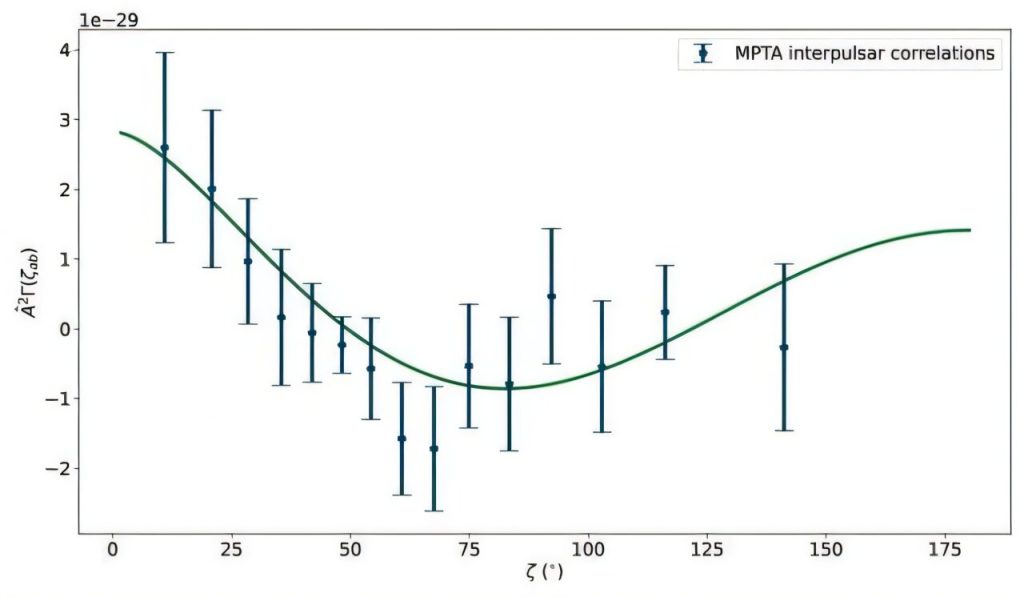
MeerKAT confirms the gravitational wave background of the universe in record time (Image Credit: Phys.org)

The universe is a turbulent place. Stars are exploding, neutron stars collide, and supermassive black holes are merging. All of these things and many more create gravitational waves. As a result, the cosmos is filled with a rippling sea of gravitational vibrations.
While we have been able to directly detect gravitational waves since 2016, gravitational wave astronomy is still in its infancy. We have only been able to observe the gravitational ripples of colliding stellar black holes. Even then, all we can really detect is the final gravitational chirp created in the last moments of merging.
We can, however, gather indirect evidence of the cosmic background of gravitational waves. Last year, the North American Nanohertz Observatory for Gravitational Waves (NANOGrav) released their first observations, which were based on millisecond pulsars.
The idea behind the NANOGrav project is that pulsars emit very regular radio pulses. Millisecond pulsars are just rapidly rotating neutron stars that happen to sweep a beam of radio energy in our direction with each rotation. So, unless a neutron star experiences a rare starquake, the pulsar timing is so consistent we can use it as a cosmic clock. This means any small variation in the timing is due to a change in relative motion.
As the cosmic gravitation waves ripple past a pulsar, its observed timing changes slightly. The shift isn’t large enough to observe with an individual pulsar, but it is large enough that a statistical analysis of many pulsars reveals the gravitational waves.
In the 2023 results, NANOGrav found evidence of cosmic gravitational waves but didn’t have enough data to pin down the source. But even this was a tremendous result. It took 15 years of observations just to prove the existence of these cosmic waves. Now a new observatory has released a data set, and it’s a game changer.
The MeerKat radio array is a collection of 64 antennas located in South Africa and run by the South African Radio Astronomy Observatory (SARAO). This week, SARAO released a series of papers on their results after just four and a half years. The papers have been accepted for publication in the Monthly Notices of the Royal Astronomical Society and are available on the arXiv preprint server. A previous paper on the NANOGrav data set was published in The Astrophysical Journal Letters.
Where NANOGrav looked at 67 millisecond pulsars, MeerKAT gathered data on 83. It observed these pulsars with a similar resolution as NANOGrav, but did so in a third of the time. These results again confirm the existence of cosmic gravitational waves, but, like the NANOGrav, don’t confirm the origin. We still need more data to prove they are generated by binary black holes in the Milky Way. But now that we have two observational teams working on it, that necessary evidence should be found in the relatively near future.
More information:
Kathrin Grunthal et al, The MeerKAT Pulsar Timing Array: Maps of the gravitational-wave sky with the 4.5 year data release, arXiv (2024). DOI: 10.48550/arxiv.2412.01214
Matthew T. Miles et al, The MeerKAT Pulsar Timing Array: The first search for gravitational waves with the MeerKAT radio telescope, arXiv (2024). DOI: 10.48550/arxiv.2412.01153
Matthew T. Miles et al, The MeerKAT Pulsar Timing Array: The 4.5-year data release and the noise and stochastic signals of the millisecond pulsar population, arXiv (2024). DOI: 10.48550/arxiv.2412.01148
Gabriella Agazie et al, The NANOGrav 15 yr Data Set: Evidence for a Gravitational-wave Background, The Astrophysical Journal Letters (2023). DOI: 10.3847/2041-8213/acdac6
Journal information:
arXiv
,
Astrophysical Journal Letters
,
Monthly Notices of the Royal Astronomical Society
Provided by
Universe Today
MeerKAT confirms the gravitational wave background of the universe in record time (2024, December 5)
retrieved 5 December 2024
from https://phys.org/news/2024-12-meerkat-gravitational-background-universe.html
part may be reproduced without the written permission. The content is provided for information purposes only.








